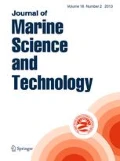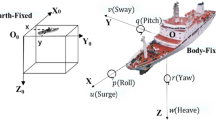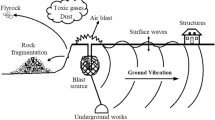Abstract
There are certain limitations when empirical formulas are used to predict the ship hull vertical vibration. Natural frequency of ship’s vertical vibration is predicted by support vector machine (SVM), which possesses many characteristics such as small sample learning, global optimization and strong generalization. Considering the parameters that influence the natural frequency of ship’s vertical vibration are much more, a grey relation model between ship’s main parameters and natural frequency of ship’s vertical vibration is established by grey relational analysis theory to get the grey correlation degree of each parameter. The parameters with greater correlation degree are used as input data and the measured values of natural frequency of vertical vibration are used as output data in SVM to build the nonlinear regression model of the natural frequency of vertical vibration. Natural frequencies of eight ships’ vertical vibration are predicted by the nonlinear regression model, and the results are coincident with the measured values. The proposed method in this paper is proved to be accurate and feasible, which provides a new idea to the prediction of natural frequency of ship’s overall vertical vibration.


Similar content being viewed by others
References
Jin XD, Zhao DY (2000) Ship vibration. Shanghai Jiaotong University Press, Shanghai
Hirowatari T (1958) On the natural frequencies of the flexural vibration of ships’ hull. J Soc Nav Archit Jpn 102:135–142
Kumai T (1967) On the estimation of natural frequencies of vertical vibration of ships. J Soc Nav Archit Jpn 121:175–182
Nagamoto R, Ushijima M, Nakano S (1968) On the natural frequency of main hull vibration. J Soc Nav Archit Jpn 35:131–155
Zhao DY (1979) On the approximate calculation of the natural frequency of vertical modes of main hull vibrating. J Dalian Univ Technol 18:113–126
Weng CJ (1978) Estimation of natural frequency of free vibration for riverboat. J Wuhan Univ Technol 2:45–52
Det Norske Veritas (1983) Prevention of harmful vibration in ships. Det Norske Veritas, Oslo
Okada Y (1983) Shipbuilding design handbook. Kansai Society of Naval Architects, Tokyo
Zhao DY et al (1993) Calculation method of natural frequency for ship’s overall vibration. China Biaozhun Press, Beijing
Vapnik V (1998) Statistical learning theory. Wiley, New York
Taboada J, Matias JM (2007) Creating a quality map of a slate deposit using support vector machines. J Comput Appl Math 204:84–94
Inglada J (2007) Automatic recognition of man-made objects in high resolution optical remote sensing images by SVM classification of geometric image features. ISPRS J Photogramm Remote Sens 62:236–248
Gryllias KC, Antoniadis IA (2012) A support vector machine approach based on physical model training for rolling element bearing fault detection in industrial environments. Eng Appl Artif Intell 25:326–344
Muralidharan V, Sugumaran V, Indira V (2014) Fault diagnosis of monoblock centrifugal pump using SVM. Eng Sci Technol Int J 4:1–6
Suganyadevi MV, Babulal CK (2014) Support vector regression model for the prediction of loadability margin of a power system. Appl Soft Comput 24:304–315
Thissen U, van Brakel R, de Weijer AP, Melssen WJ, Buydens LMC (2003) Using support vector machines for time series prediction. Chemom Intell Lab Syst 69:35–49
Deng JL (2002) Grey theory. Huazhong University of Science Press, Wuhan
Liu SF, Dang YG, Fang ZG (2004) Grey system theory and its application. Science Press, Beijing
Wei GW (2011) Grey relational analysis model for dynamic hybrid multiple attribute decision making. Knowl Based Syst 24:672–679
Nello C, John ST (2000) Support vector machines and other kernel-based learning methods. Cambridge University Press, London
Author information
Authors and Affiliations
Corresponding author
About this article
Cite this article
Yin, Ym., Cui, Hy., Hong, M. et al. Prediction of the vertical vibration of ship hull based on grey relational analysis and SVM method. J Mar Sci Technol 20, 467–474 (2015). https://doi.org/10.1007/s00773-014-0299-5
Received:
Accepted:
Published:
Issue Date:
DOI: https://doi.org/10.1007/s00773-014-0299-5




